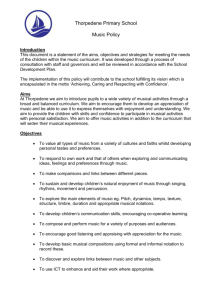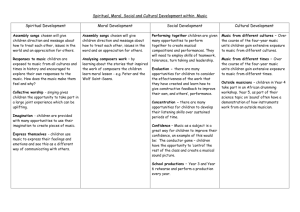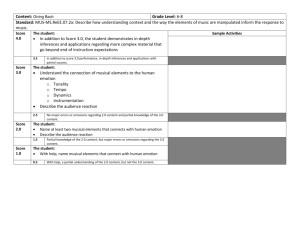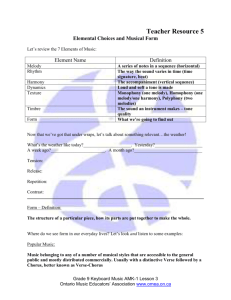Students will identify music from the following cultures and periods.
advertisement
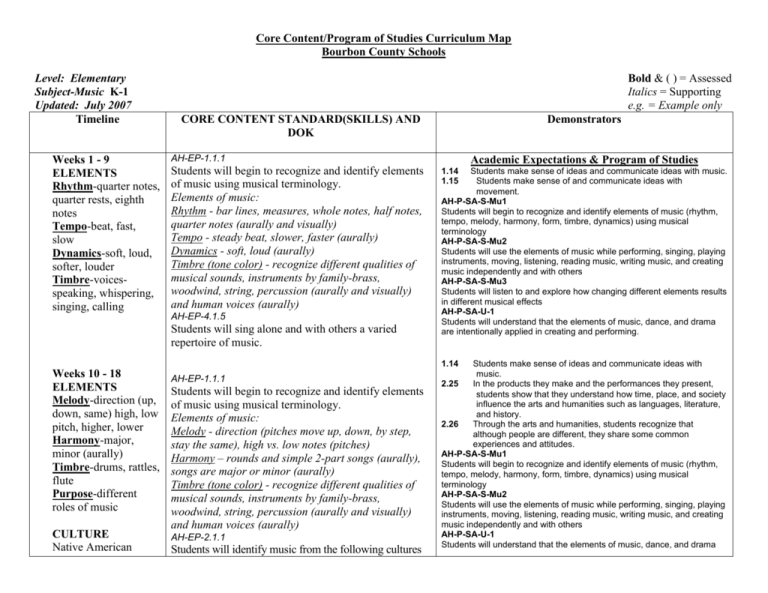
Core Content/Program of Studies Curriculum Map Bourbon County Schools Level: Elementary Subject-Music K-1 Updated: July 2007 Timeline Weeks 1 - 9 ELEMENTS Rhythm-quarter notes, quarter rests, eighth notes Tempo-beat, fast, slow Dynamics-soft, loud, softer, louder Timbre-voicesspeaking, whispering, singing, calling Bold & ( ) = Assessed Italics = Supporting e.g. = Example only CORE CONTENT STANDARD(SKILLS) AND DOK Demonstrators AH-EP-1.1.1 Students will begin to recognize and identify elements of music using musical terminology. Elements of music: Rhythm - bar lines, measures, whole notes, half notes, quarter notes (aurally and visually) Tempo - steady beat, slower, faster (aurally) Dynamics - soft, loud (aurally) Timbre (tone color) - recognize different qualities of musical sounds, instruments by family-brass, woodwind, string, percussion (aurally and visually) and human voices (aurally) AH-EP-4.1.5 Students will sing alone and with others a varied repertoire of music. Academic Expectations & Program of Studies 1.14 1.15 Students make sense of ideas and communicate ideas with music. Students make sense of and communicate ideas with movement. AH-P-SA-S-Mu1 Students will begin to recognize and identify elements of music (rhythm, tempo, melody, harmony, form, timbre, dynamics) using musical terminology AH-P-SA-S-Mu2 Students will use the elements of music while performing, singing, playing instruments, moving, listening, reading music, writing music, and creating music independently and with others AH-P-SA-S-Mu3 Students will listen to and explore how changing different elements results in different musical effects AH-P-SA-U-1 Students will understand that the elements of music, dance, and drama are intentionally applied in creating and performing. 1.14 Weeks 10 - 18 ELEMENTS Melody-direction (up, down, same) high, low pitch, higher, lower Harmony-major, minor (aurally) Timbre-drums, rattles, flute Purpose-different roles of music CULTURE Native American AH-EP-1.1.1 Students will begin to recognize and identify elements of music using musical terminology. Elements of music: Melody - direction (pitches move up, down, by step, stay the same), high vs. low notes (pitches) Harmony – rounds and simple 2-part songs (aurally), songs are major or minor (aurally) Timbre (tone color) - recognize different qualities of musical sounds, instruments by family-brass, woodwind, string, percussion (aurally and visually) and human voices (aurally) AH-EP-2.1.1 Students will identify music from the following cultures Students make sense of ideas and communicate ideas with music. 2.25 In the products they make and the performances they present, students show that they understand how time, place, and society influence the arts and humanities such as languages, literature, and history. 2.26 Through the arts and humanities, students recognize that although people are different, they share some common experiences and attitudes. AH-P-SA-S-Mu1 Students will begin to recognize and identify elements of music (rhythm, tempo, melody, harmony, form, timbre, dynamics) using musical terminology AH-P-SA-S-Mu2 Students will use the elements of music while performing, singing, playing instruments, moving, listening, reading music, writing music, and creating music independently and with others AH-P-SA-U-1 Students will understand that the elements of music, dance, and drama Timeline CORE CONTENT STANDARD(SKILLS) AND DOK and periods. Cultures: Native American, Traditional Appalachian, West African Periods: Colonial American AH-EP-3.1.1 Students will experience music created for a variety of purposes. Purpose (different roles of music) Ceremonial - music created or performed for rituals or celebrations (e.g., patriotic music, music for worship) Recreational - music for entertainment (e.g., music for play such as game songs, music for dances and social events, music for physical activities, music as a hobby) Artistic Expression - music created with the intent to express or communicate one’s emotions, feelings, ideas, experience (e.g., music created and performed in a concert setting for an audience) AH-EP-4.1.5 Students will sing alone and with others a varied repertoire of music. Weeks 19 - 28 ELEMENTS Form-AB, ABA CULTURE West African Demonstrators are intentionally applied in creating and performing. AH-P-HA-S-Mu1 Students will begin to associate music they listen to or perform with specific cultures (Native American, Appalachian, West African); describe in simple terms how the music reflects the cultures AH-P-HA-S-Mu2 Students will begin to associate music they listen to or perform with the Colonial American period in history; describe in simple terms how the music reflects the Colonial American time period AH-P-HA-S-Mu3 Students will begin to describe the music of specific cultures using music terminology AH-P-HA-U-1 Students will understand that the arts are powerful tools for understanding human experiences both past and present. AH-P-HA-U-2 Students will understand that the arts help us understand others’ (often very different) ways of thinking, working, and expressing ourselves. AH-P-HA-U-3 Students will understand that the arts play a major role in the creation and defining of cultures and building civilizations. AH-P-PCA-U-1 Students will understand that the arts fulfill a variety of purposes in society (e.g., to present issues and ideas, to entertain, to teach or persuade, to design, plan and beautify). AH-P-PCA-U-2 Students will understand that the arts have value and significance for daily life. They provide personal fulfillment, whether in vocational settings, avocational pursuits, or leisure. AH-P-PCA-S-Mu1 Students will begin to develop an awareness of the purposes for which music is created (e.g., ceremonial, recreational, artistic expression) AH-P-PCA-S-Mu2 Students will listen to and perform music created to fulfill a variety of specific purposes AH-EP-1.1.1 1.14 2.25 Students will begin to recognize and identify elements of music using musical terminology. Elements of music: Form - call and response form, AB form and ABA form (aurally) 2.26 Students make sense of ideas and communicate ideas with music. In the products they make and the performances they present, students show that they understand how time, place, and society influence the arts and humanities such as languages, literature, and history. Through the arts and humanities, students recognize that although people are different, they share some common experiences and attitudes. Timeline TIME PERIOD Colonial STYLES OF MUSIC CORE CONTENT STANDARD(SKILLS) AND DOK AH-EP-1.1.2 Students will identify various styles of music (spirituals, game songs, folk songs, work songs, lullabies, patriotic, bluegrass). AH-EP-2.1.1 Students will identify music from the following cultures and periods. Cultures: Native American, Traditional Appalachian, West African Periods: Colonial American AH-EP-4.1.5 Students will sing alone and with others a varied repertoire of music. Demonstrators AH-P-SA-S-Mu1 Students will begin to recognize and identify elements of music (rhythm, tempo, melody, harmony, form, timbre, dynamics) using musical terminology AH-P-SA-S-Mu2 Students will use the elements of music while performing, singing, playing instruments, moving, listening, reading music, writing music, and creating music independently and with others AH-P-HA-U-1 Students will understand that the arts are powerful tools for understanding human experiences both past and present. AH-P-HA-U-2 Students will understand that the arts help us understand others’ (often very different) ways of thinking, working, and expressing ourselves. AH-P-HA-U-3 Students will understand that the arts play a major role in the creation and defining of cultures and building civilizations. AH-P-PCA-U-1 Students will understand that the arts fulfill a variety of purposes in society (e.g., to present issues and ideas, to entertain, to teach or persuade, to design, plan and beautify). AH-P-PCA-U-2 Students will understand that the arts have value and significance for daily life. They provide personal fulfillment, whether in vocational settings, avocational pursuits, or leisure. AH-P-PCA-U-3 Students will understand that the arts provide forms of nonverbal communication that can strengthen the presentation of ideas and emotions. AH-P-PCA-S-Mu1 Students will begin to develop an awareness of the purposes for which music is created (e.g., ceremonial, recreational, artistic expression) AH-P-PCA-S-Mu2 Students will listen to and perform music created to fulfill a variety of specific purposes 1.14 2.26 Weeks 29 - 31 ELEMENTS Timbre- sounds of instruments CULTURE AH-EP-1.1.1 Students will begin to recognize and identify elements of music using musical terminology. Elements of music: Timbre (tone color) - recognize different qualities of musical sounds, instruments by family-brass, Students make sense of ideas and communicate ideas with music. Through the arts and humanities, students recognize that although people are different, they share some common experiences and attitudes. AH-P-SA-S-Mu1 Students will begin to recognize and identify elements of music (rhythm, tempo, melody, harmony, form, timbre, dynamics) using musical terminology AH-P-HA-U-1 Students will understand that the arts are powerful tools for understanding human experiences both past and present. Timeline Appalachian CORE CONTENT STANDARD(SKILLS) AND DOK woodwind, string, percussion (aurally and visually) and human voices (aurally) AH-EP-2.1.1 Students will identify music from the following cultures and periods. Cultures: Native American, Traditional Appalachian, West African Periods: Colonial American AH-EP-4.1.5 Students will sing alone and with others a varied repertoire of music. Demonstrators AH-P-HA-U-2 Students will understand that the arts help us understand others’ (often very different) ways of thinking, working, and expressing ourselves. AH-P-HA-U-3 Students will understand that the arts play a major role in the creation and defining of cultures and building civilizations. AH-P-PCA-U-1 Students will understand that the arts fulfill a variety of purposes in society (e.g., to present issues and ideas, to entertain, to teach or persuade, to design, plan and beautify). AH-P-PCA-U-2 Students will understand that the arts have value and significance for daily life. They provide personal fulfillment, whether in vocational settings, avocational pursuits, or leisure. AH-P-PCA-U-3 Students will understand that the arts provide forms of nonverbal communication that can strengthen the presentation of ideas and emotions. AH-P-PCA-S-Mu1 Students will begin to develop an awareness of the purposes for which music is created (e.g., ceremonial, recreational, artistic expression) AH-P-PCA-S-Mu2 Students will listen to and perform music created to fulfill a variety of specific purposes



